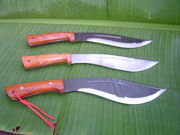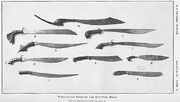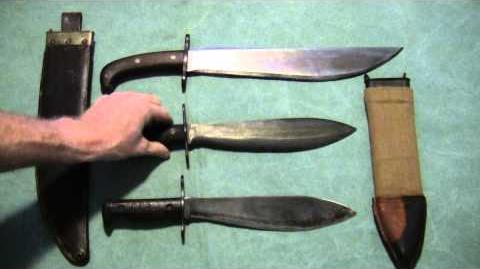

The Bolo: Combination piercing and chopping weapons; agricultural knives and jungle tools.

U.S. Military Bolo's
"The Bolo knife was designed to be a multi-purpose field tool, handling the jobs of the machete, camp axe and traditional field knife."[]
Basic and important information on the Bolo knife by an expert.
bo·lo[]
1. [boh-loh] noun, plural bo·los. A large, heavy single edged knife or machete designed for hacking, chopping and heavy cutting. Dual purposed as tool and weapon.
A bolo is a large cutting tool of Filipino origin similar to the machete, used particularly in the jungles of Indonesia, the Philippines, and in the sugar fields of Cuba. The primary use for the bolo is clearing vegetation, whether for agriculture or during trail blazing.
The bolo is called an iták or sundáng in Tagalog while in Hiligaynon, the blade is referred to as either a binangonor a talibong.Bolos are also used as military weapons and as such they were a particular favorite of the Filipino resistance during the 1898 Philippine Revolution against Spain, the Philippine-American War, and the Commonwealth period.
For this reason the study of the bolo is common in Filipino martial arts, such as Balintawak Eskrima, Pekiti-Tirsia Kali and Modern Arnis.[1]
Design[edit][]
Bolos are characterized by having a native hardwood or animal horn handle, a full tang, and by a blade that both curves and widens, often considerably so, at its tip. This moves the centre of gravity as far forward as possible, giving the knife extra momentum for chopping vegetation. So-called "jungle bolos", intended for combat rather than agricultural work, tend to be longer and less wide at the tip.
Types[]
Various types of bolos are employed. An assortment of bolos and related implements include:
1.The all-purpose bolo: Used for all sorts of odd jobs, including breaking open coconuts.
2.The haras: Similar to a small scythe, it is used for cutting tall grass.
3.The kutsilyo: The term comes from the Spanish word cuchillo, meaning knife. Generally used to kill and bleed pigs during slaughter.
4.A smaller bolo.
5.The bolo-guna: A bolo specifically shaped for digging out roots and weeding.
6.The garab: Used to harvest rice.
7.A large pinuti: Traditionally it is tipped in snake, spider or scorpion venom and used for self-defense.
8.The sundang: Supposedly used mainly to open coconuts. The sundang, also called "tip bolo" or itak, was a popular weapon of choice in the revolution against the Spanish colonial government and during the Philippine–American War.
Other uses of the term[]
In the U.S. military, the slang term "to bolo" – to fail a test, exam or evaluation, originated from the Philippine-American guerrilla forces during World War II; those guerrillas who failed to demonstrate proficiency in marksmanship were issued bolos instead of firearms so as not to waste scarce ammunition.[3]
Used in the Phillipines and by the U.S. Army. Origin: Phillipine Spanish, 1900 - 1905.
2 . The successor to the Main Battle Tank which was limited to Direct Fire in the Close Support Role. The Bolo was developed with the upgrading of the Indirect Fire, Active Protection, Electronic and Cyber-Warfare capabilities to that same "Close Support" role. The main battle tank fulfills the role the British had once called the 'universal tank', filling almost all ground battlefield roles.
The Bolo fulfills ALL ground battlefield roles.
Bolo Avatar 52759 (talk) 01:51, July 23, 2013 (UTC)